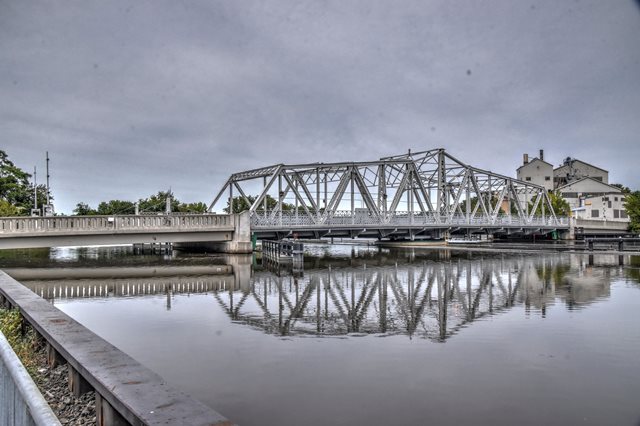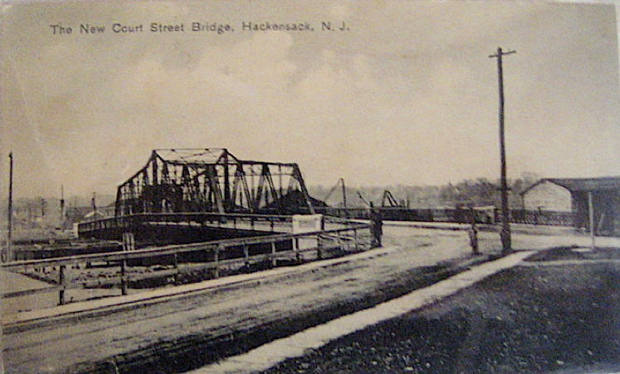We Recommend:
Bach Steel - Experts at historic truss bridge restoration.
BridgeHunter.com Phase 1 is released to the public! - Visit Now
Court Street Bridge
Harold J. Dillard Memorial Bridge

Primary Photographer(s): Nathan Holth
Bridge Documented: September 5, 2019
Hackensack: Bergen County, New Jersey: United States
Metal Multiple-Type-Connected Warren Through Truss, Movable: Swing (Center Bearing Center Pier) and Approach Spans: Pre-Stressed Concrete Box Beam, Fixed
1908 By Builder/Contractor: F. R. Long Company of Hackensack, New Jersey
2012
180.0 Feet (54.9 Meters)
315.0 Feet (96 Meters)
30 Feet (9.14 Meters)
1 Main Span(s) and 2 Approach Span(s)
20004A

View Information About HSR Ratings
Bridge Documentation
This classic example of a through truss highway swing bridge has been extensively rehabilitated and preserved. The bridge was built by F. R. Long Company of Hackensack, New Jersey whose shop was located right next to this bridge when it was built.
View Archived National Bridge Inventory Report - Has Additional Details and Evaluation
Above: Historical postcard of bridge.
Information and Findings From New Jersey's Historic Bridge InventorySummary The center-bearing swing-span Warren thru truss bridge with two steel deck girder approach spans is supported on a concrete substructure. Alterations such as reinforcement of the lower chords in 1974 and repairs to floorbeams and stringers have not compromised the integrity of design. The bridge is one of the only remaining operable through truss swing spans in NJ. It was built by a prominent local contractor, and is a technologically significant example of a rare surviving bridge type. Setting/Context The bridge carries a 2-lane urban connector over a major river between downtown Hackensack and Bogota. A concrete batching plant and the Bergen County Court House are in close proximity to the bridge. The S.S. Ling Submarine is moored just upstream of the bridge. This bridge is the upstream-most movable span still in operation on the Hackensack River. Physical Description Constructed in 1907, the 317' long center-bearing through truss swing-span bridge supported on a concrete substructure has steel deck girder approach spans. The truss has riveted connections, and the diagonals and top and bottom chord members are composed of back-to-back channels with lacing. The verticals are 4 angles with lacing. The operating mechanism of the swing-span has undergone several maintenance repairs and remains operational. The operators house, set on the upstream corner of the Hackensack side of the river, does not appear to date to the original construction, however no documentation of the house was found. The original decorative metal railings are intact at the approach spans but chain-link-fences were placed along the sidewalks on the swingspan in 1974. The timber fenders at the swing-span piers have been reconstructed several times. In 1950 the original concrete jack arch deck was replaced with a reinforced slab and the stringers were encased. In 1974 the truss lower chord was reinforced for its full length, plates were added at the bottom flanges of the end floor beams, and new stringer seat angle connections were added at the floor beams. Historical and Technological Significance The riveted through truss bridge is one of several swing-span crossings of the Hackensack River, an important navigable waterway instrumental in the growth and industrial development of Bergen County. Constructed in 1907, the span replaced an earlier swing-span bridge. The builder, F.R. Long Company, was a New York firm that was a prolific bridge contractor in Bergen County, and it incorporated in New Jersey in 1899 moving its major operations to Hackensack at a site adjacent to the bridge. Although the span has undergone some alterations, it is a well-preserved and operational example of the swing-span trusses over the Hackensack River built by a prominent contractor in Bergen County. 02000I1 spanning the Passaic River in Rutherford Borough is also a well-preserved example of an operational swing-span through truss in the county. Sources Bibliography: Bergen County Engineers Office. (Plans). Bergen County Division of Cultural and Historic Affairs. Folio 408. Bridge Considered Historic By Survey: Yes |
![]()
Photo Galleries and Videos: Court Street Bridge
Bridge Photo-Documentation
Original / Full Size PhotosA collection of overview and detail photos. This gallery offers photos in the highest available resolution and file size in a touch-friendly popup viewer.
Alternatively, Browse Without Using Viewer
![]()
Bridge Photo-Documentation
Mobile Optimized PhotosA collection of overview and detail photos. This gallery features data-friendly, fast-loading photos in a touch-friendly popup viewer.
Alternatively, Browse Without Using Viewer
![]()
Maps and Links: Court Street Bridge
Coordinates (Latitude, Longitude):
Search For Additional Bridge Listings:
Bridgehunter.com: View listed bridges within 0.5 miles (0.8 kilometers) of this bridge.
Bridgehunter.com: View listed bridges within 10 miles (16 kilometers) of this bridge.
Additional Maps:
Google Streetview (If Available)
GeoHack (Additional Links and Coordinates)
Apple Maps (Via DuckDuckGo Search)
Apple Maps (Apple devices only)
Android: Open Location In Your Map or GPS App
Flickr Gallery (Find Nearby Photos)
Wikimedia Commons (Find Nearby Photos)
Directions Via Sygic For Android
Directions Via Sygic For iOS and Android Dolphin Browser
USGS National Map (United States Only)
Historical USGS Topo Maps (United States Only)
Historic Aerials (United States Only)
CalTopo Maps (United States Only)


